Beyond Random: Cracking the Code on Zoomer Humor
Generation Z has a distinct sense of humor that’s been described as “dark,” “random,” and “absurd.” But efforts to articulate what exactly makes Zoomer humor different tend to run into a problem: If dark, random absurdity are what separate Generation Z’s humor from the rest, then those qualities shouldn’t be prominent in other generations’ humor. But they are.
Millennials love Eric Andre’s absurdly violent parody of a talk show. They even love the gleefully absurd comedy in 70’s-era Monty Python sketches, which predate Millennials and Gen Z entirely. So randomness and absurdity don’t automatically make humor “Gen Z.”
We could just give up and say that humor is timeless, that Gen Z and Millennials are pretty much the same, and that generational “wars” are just made-up controversies. While it’s true that sites like BuzzFeed exaggerate intergenerational conflicts over hairstyles and fashion to get clicks, that doesn’t mean there aren’t any legitimate differences between generations.
The humor divide is one of those legitimate differences. It’s well documented in memes that describe Gen Z’s humor as sharply, recognizably different from that of Millennials and Baby Boomers:
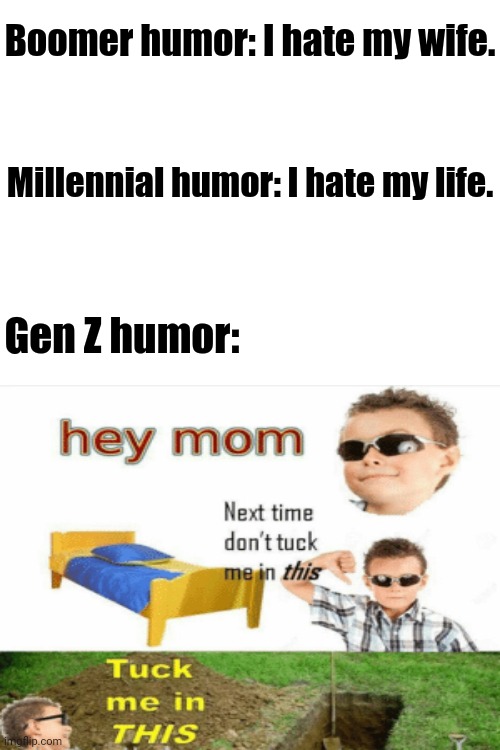
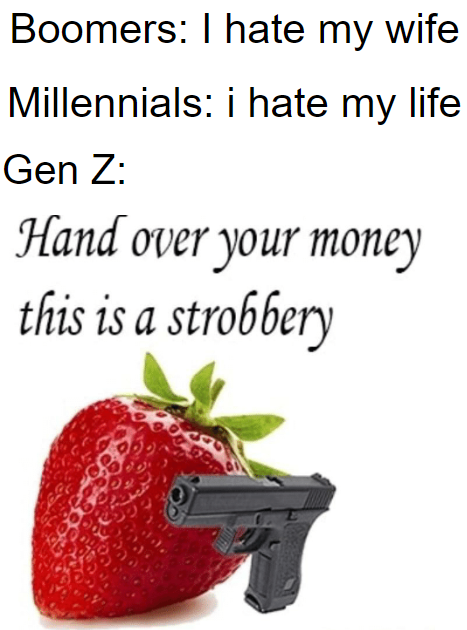
These memes provide examples of Zoomer humor, but they don’t clearly explain what it is.
To understand and discuss the kinds of memes labeled “Gen Z” in the above examples, the internet has embraced the concept of “layers” of irony. When memes become parodies of things that were already parodies to begin with, irony is applied to irony, creating what’s called “post-irony” and “meta-irony.” Post and meta ironic memes can be dizzying and hard to decipher without a working knowledge of what’s being parodied, a knowledge you can only obtain through lots of previous experience with the internet.
If you look for a commentary on Gen Z humor, chances are it will conclude that Zoomer humor is distinguished by the use of one or both of the secondary types of irony. But while ironic layers are a useful way to understand individual memes, no one layer defines Zoomer humor as a whole. There are plenty of regular ironic memes that still exemplify a uniquely Gen Z comedic sense, and it’s not like Gen Z invented higher orders of irony.
The real difference lies elsewhere. To crack this, we have to begin, of all places, with Veggie Tales.
The Rise of Random
Veggie Tales predicted that, by taking to its logical extreme the idea that jokes are funny when their punchlines are unexpected, soon, all humor would be randomly generated:
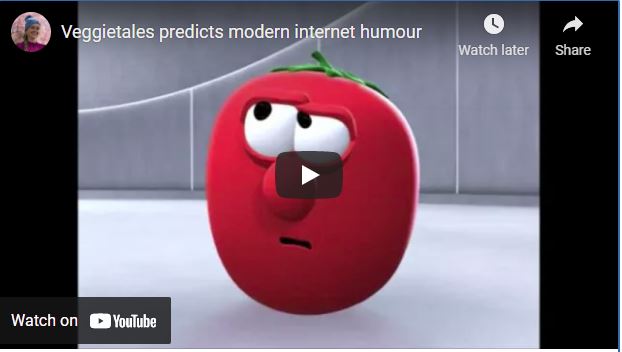
In the future, the classic joke will go:
Why did the chicken cross the road?
I don’t know, why?
Weed eater!
Granted, the joke works in part because, in the show, it’s couched in an absurd scenario. It’s delivered by two robots dressed as carnival barkers, and essentially sets you up for failure, by saying “don’t laugh at this, it’s not funny.” The choice of the “random” word also helps. “Weed eater” is already a kind of silly term that makes you picture a device that literally consumes backyard flora. I don’t think “diamond” “paperclip” or “rock” would have been as funny as “weed eater,” and the show’s writers probably didn’t use a random word generator to choose the punchline.
But even if their own example wasn’t truly randomly generated, it’s hard to say Veggie Tales’ prediction hasn’t come true. Consider “Google translated songs,” which involve running the lyrics of popular songs through multiple languages on Google Translate, returning them back to English, and re-recording the music with lyrics which, thanks to imperfect algorithms, are riddled with nonsense.
Here too, the scenario aids the humor – a supposedly smart algorithm producing illiterate results is amusing – but the people who watch and re-watch these videos are essentially just laughing at the random static that comes out of Google Translate.
There’s also the classic asdfmovie videos, with memorable random exchanges like, “I baked you a pie.” “Oh boy what flavor?” “PIE FLAVOR.” Asdfmovie exploded during what many now see as an era on YouTube where random humor flourished. Whether it was Smosh with its absurd “Food Battle” series, or compilations of absurd glitches in otherwise realistic video games, random was all the rage.
The Veggie Tales writers feared randomness would take over comedy and deprive us of meaningful, substantive humor. And while that really hasn’t happened, the craving for random does seem to have intensified. Generation Z now demands memes that inject pure, pharmaceutical-grade randomness directly into their bloodstreams:
Ha! Very random.
Or how about this:
Wait… what do you mean “Millennial humor?” We’ve gone in a circle and run right back into the problem we had at the outset: “Surreal, dark and completely meaningless” humor, as the Washington Post article referenced in the above meme calls it, is not exclusive to Gen Z.
Don’t worry, all is not lost. It’s true that bleak randomness in memes reached a fever pitch in the last 5-10 years, and was embraced by the tail end of the Millennial generation, but the changing of the generational guard brought changes in the meme world.
Gen Z still loves randomness. In fact, it’s foundational to their humor. But it is precisely because of that strong foundation in randomness that Gen Z has been able to build a sense of humor that’s not random at all.
Subverting Random
We can tell when something is random. We know that a series of numbers like 0123456789 is obviously not random, whereas 7842094692 at least feels random. Pedantic mathematicians will inform you that both are actually equally likely to be the result of generating a 10-digit random number, but here I only want to illustrate that we have expectations about randomness. When our pattern-seeking brains fail to recognize a pattern, we get the sense that what we’re seeing is random.
With humor, we get a similar sense. The Veggie Tales “weed eater” joke feels random because there is no obvious connection between the setup and the punchline.
Paradoxically, this means that we have expectations for random humor. And where there’s an expectation, there’s an opportunity to subvert it to create more humor. Inserting a meaningful punchline where a random one is expected is the defining feature of Gen Z humor.
In keeping with the irony/post-irony language already used in meme discussions, I’ll call Gen Z’s subversion of random humor post-randomness.
To illustrate, here’s three variations on the same joke:
Classic:
Q: How many tickles does it take to make an Octopus laugh?
A: Ten Tickles (sounds like “tentacles”)
Random:
Q: How many tickles does it take to make an Octopus laugh?
A: Forty Seven
Post-random:
Q: How many tickles does it take to make an Octopus laugh?
A: TWENTY ONE
Those in the know understand that “twenty one” is funny both because it’s not a coherent answer to the question, but also because it references a wildly popular joke from Vine, the defunct 6.5 second video sharing app.
But here’s the kicker: If you’d never seen the Vine before, for you, “twenty one” is the same as “forty seven” or any other random punchline. In fact, you might not be aware that you’re missing anything. Because no one element of a post-random joke actually has to land for it to be funny to an audience that likes random humor, a world of possibilities opens up for intricately layered references pulled from disparate sources. With the internet providing a set of shared experiences to refer to, it’s surprising how much meaning can be packed into relatively small images.
Take a look at this meme:

The caption has no relationship with the cartoon character pictured. It has the feeling of a random joke. But the image is far from random. It’s bursting with references to tons of preexisting trends and memes.
If you’d seen Jimmy Neutron, you’d recognize the character as Sheen, recognize that he isn’t even the show’s main character, and that the show itself has been off the air for years and is an odd thing to put in a modern meme.
If you knew about “T-posing,” you’d understand why Sheen has his arms outstretched. If you knew that the “Impact” font this meme uses was once exclusively used in sincere memes, you’d understand that the font is ironic here given the meme’s absurd caption.
If you were familiar with the internet’s attitude on mental illness, you’d recognize that the caption echoes the popular refrain that depression and suicidal ideation are so endemic in today’s youth that pointing it out is almost trivial.
Anyone who likes this meme could understand any combination of these layers – or none of them at all – and still find the image funny.
When no one reference makes or breaks a joke because the audience is willing to laugh at apparently meaningless memes, creators can pack in as much obscure, specific content as they want.
The resulting post-random memes are deeply meaningful, yet still maintain the whimsical, all-over-the-place feeling of random humor.
The delightful contrast between apparent randomness and convoluted meaning are a big part of post-random humor’s draw. Zoomers revel in the fact that many memes can’t be deciphered without a heavy internet user’s knowledge of the latest flash-in-the-pan trends:
Truth be told, I don’t think future schools will be anxious to explain that because this meme grafts the “it’s free real estate” meme over the meme of an anime character misidentifying the thing he’s pointing at, the joke here is that cats like to jump on their owners’ laps without invitation.

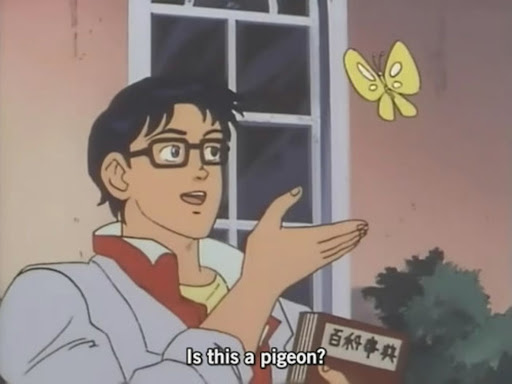
It’s not a very sophisticated joke once you understand what’s supposed to be substituted for what. The joy comes from being able to piece everything together and discover meaning in something cryptic. The combination of disparate, unrelated elements into one joke recreates the disjointed feeling of random humor but adds a recognizable meaning. This is not simply a cat joke, nor is it a random joke. It’s a post-random take on cat jokes that comments on meme culture itself even as the joke is being delivered. Post-randomness, not any particular subject matter or layer of irony, is what truly makes Gen Z’s humor distinct.
Why all this matters
Humor is a window into the psyche. If Zoomer humor is truly unique, we should expect the Zoomer worldview to be unique as well.
The worldview revealed by Millennial humor has been widely discussed. The Washington Post article “Why is Millennial Humor So Weird?” describes Millennials’ bleak, random humor as a response to a senseless world:
“In this weird world of the surreal and bizarre, horror mingles with humor, and young people have space to play with emotions that seem more and more to proceed from ordinary life — the creeping suspicion that the world just doesn’t make sense.”
The stereotype of Millennial humor is that it focuses on existential dread.
Recall this meme:
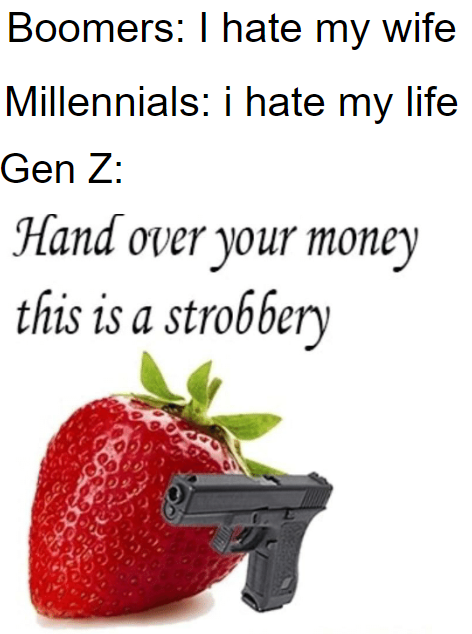
While Boomers simply joke about their problems, Millennials joke about the bleak hopelessness that lies beneath their problems. They stare into the abyss, chuckling nervously, hoping the abyss doesn’t stare back. Gen Z takes a different approach.
Gen Z treats the blankness as a blank canvas. In their humor, they’ve taken meaningless randomness and used it to create meanings of surprising intricacy and subtlety. If random humor was, for Millennials, a sign of deep existential hopelessness, Gen Z’s turn away from randomness must be seen as a turn away from that hopelessness.
Gen Z is keenly aware of the world’s problems. Highlighting and criticizing those problems are integral to Gen Z’s culture. But beneath their complaints lurks a fundamentally constructive, hopeful disposition, an exciting prospect in a generation whose influence will soon extend far beyond internet culture.